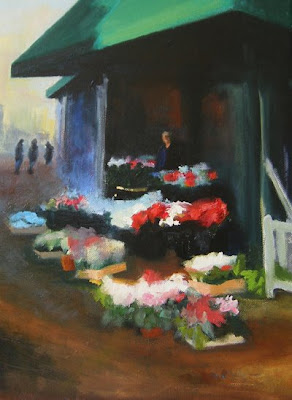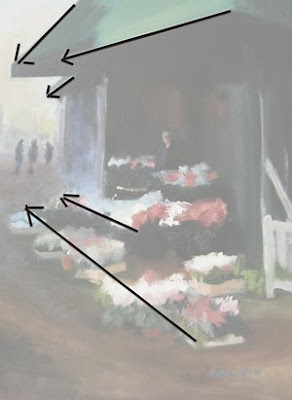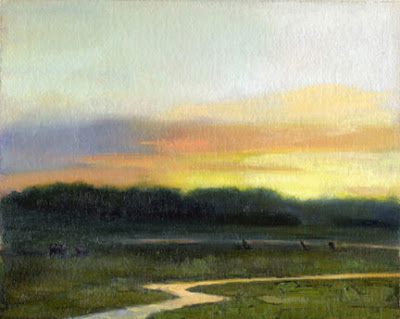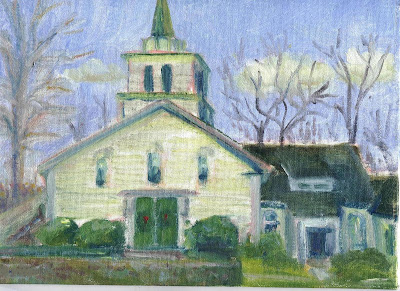 I am jurying a show again tomorrow, so tonight's post will be a little shorter than my usual. Those of you who have frequented this blog for a while know what that picture means. Its dissection time! So hand me a couple of hemostats and a bone saw, and lets carve em up!
I am jurying a show again tomorrow, so tonight's post will be a little shorter than my usual. Those of you who have frequented this blog for a while know what that picture means. Its dissection time! So hand me a couple of hemostats and a bone saw, and lets carve em up! Here's an image with an eye control problem, see below.
Here's an image with an eye control problem, see below. All of the major lines take the viewer out to the edge of the canvas on the left. This would be a better design if it lead the viewer to the woman selling the flowers in the stall.
All of the major lines take the viewer out to the edge of the canvas on the left. This would be a better design if it lead the viewer to the woman selling the flowers in the stall.Deemphasizing, which I often call deweighting some distracting elements would help with that. I have written a post on deweighting , here.
It would help this composition to "deweight" some of the bright notes that are out around the periphery of the canvas. The bright green triangle at 12 o'clock is an example. Put your hand over that and notice how the eye drops into the picture area. It is too bright for something that is so close to the rabbet (picture edge) and isn't really a main actor in the story. The white fence on the right is too assertive also. Not all of those white flowers should be super bright. If all of them were knocked down one value and those by the figure were accented with that high key white it would help draw our eye to our lead actor. I also think the three little figures on the left detract rather than add to the picture. They aren't really part of the story and they help those lines pull our eye to the left hand margin and away from the central action. They almost form a second subject. I also think this picture might benefit from a more careful delineation of the flowers. They are a fine subject, but if they are only a blur you are not extracting their full benefit in the picture. You need to get those passages to say flowers more.That will add charm to the picture.
 Here is another picture with the same flaw. It has that bright stream that leads the viewer rapidly over to.......the right hand rabbet. This would be a better painting if that stream either lead the viewer back into the picture, or stayed in the foreground as a pond and reflected the sky and the background in a pleasing way. This picture has a very nice tonality to it. That sunset really glows!
Here is another picture with the same flaw. It has that bright stream that leads the viewer rapidly over to.......the right hand rabbet. This would be a better painting if that stream either lead the viewer back into the picture, or stayed in the foreground as a pond and reflected the sky and the background in a pleasing way. This picture has a very nice tonality to it. That sunset really glows!I also think that the way the left hand group of trees drops down suddenly as it nears the edge of the canvas channels our eye left into the rabbet there, rather than to the right and stay in the painting.It is really important to control the viewers eye as it moves through your painting.
Here is the Baptist church in Rockport, Massachusetts. It was painted from a spot directly in front of my old gallery there.
 Emile Gruppe painted this church many times, here is one. lets compare what Gruppe did with this and the one up on the gurney.
Emile Gruppe painted this church many times, here is one. lets compare what Gruppe did with this and the one up on the gurney. Gruppe has moved to the left, down in front of Bruce Turners old gallery. I have heard Bruce describe him making this picture. It happened real fast. Gruppe has a less frontal view of the church which is less static. he has also managed to bring some dark shapes up against the light of the church, That gives some visual excitement in the contrast there.
Gruppe has moved to the left, down in front of Bruce Turners old gallery. I have heard Bruce describe him making this picture. It happened real fast. Gruppe has a less frontal view of the church which is less static. he has also managed to bring some dark shapes up against the light of the church, That gives some visual excitement in the contrast there.The big elms are long gone. Gruppe probably painted this after they were gone too. He painted this scene many times and continued to put them in long after the Dutch elm disease slayed them and millions of other elms.
Gruppe keeps finding ways to break up the lines of the church. He places the dark pines in front of it and runs branches across it. He breaks up the door by placing light figures in front of it. To the left of that he places dark figures in front of the light facade. He breaks up the dark pine at the right by placing a light figure in front of it. All over this painting there are bold contrasts to make it a dynamic and exciting painting. It is about that, and only nominally about the church.
IT IS HOW IT IS A PICTURE OF, AND NOT WHAT IT IS A PICTURE OF, THAT IS IMPORTANT!
One thing Gruppe knew he had to do is get the verticals plumb. Even in a loose painting like this one you have to get that right. People unconsciously look for it and if your verticals are off they will find it disconcerting.
I will return tomorrow and work over this church picture some more.
Gruppe painting from Gruppe on Painting By Emile Gruppe and Charles Movalli. which is now newly available from the Rockport Art Assoociation ( 978 .546. 6604 ) after many years of being out of print.
Here lies anonymous ( ink drawing ) by Heinrich Kley from More Drawings by Heinrich Kley, Dover Presss




4 comments:
I've been looking forward to this, and not disappointed. Very instructive. I think I'm going to paste the quote above my easel:
IT IS HOW IT IS A PICTURE OF, AND NOT WHAT IT IS A PICTURE OF, THAT IS IMPORTANT.
I like to think of it as being "king of my own little world" when I paint, putting in, or taking out, or moving over, or enhancing, or diminishing elements to further the overall concept. It's good to be king.
However, sometimes our brain fails to engage somehow in the midst of the seduction of painting and we forget to step back and check those visual clues.
STAPE,
love the sketch in the beginning of your blog. Looks like a HUEDENEE trick gone wrong.
Could you explain a little bit more about what you ment about GRUPPE knowing how to keep his VERITCALS PLUMB.
I am learning from the comparison between GROUPPES CHURCH and the one that is in blog.
JAMES
James.
I will begin with that tonight.....Stape
Deb:
Sometimes its easy to think that the subject is what its about because most people only see that. Artists who think that spend all their time trying to come up with the subject that will make them a great artist. They often believe that they can shortcut their way to the painting after they get that subject, usually using photography. Because they don't really function as visual artists, but instead as verbal descriptionists fumbling about in a foreign medium. It is impossible to put too much emphasis on what the painting actually looks like.
.....Stape
Post a Comment